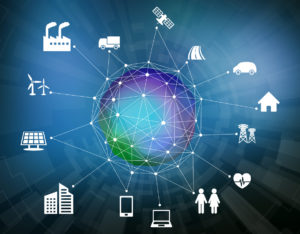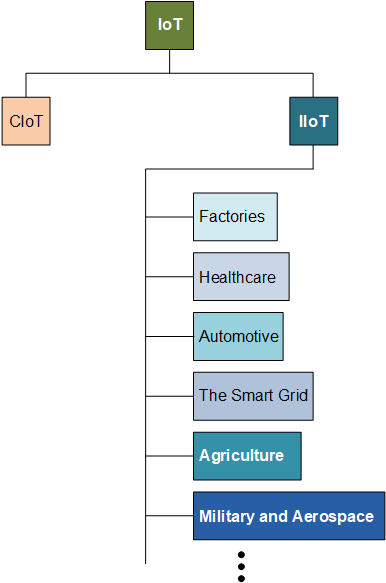
[From the last episode: IoTThe Internet of Things. A broad term covering many different applications where "things" are interconnected through the internet. systemsThis is a very generic term for any collection of components that, all together, can do something. Systems can be built from subsystems. Examples are your cell phone; your computer; the radio in your car; anything that seems like a "whole." consist of sensing, computing, communicating, and actuatingA way of controlling some device electronically. It might turn the device on or off or change a setting or property or do any other thing that the device is capable of.. SecurityRefers to whether or not IoT devices or data are protected from unauthorized viewers. and privacyRefers to whether or not information gathered about your usage of IoT devices by authorized people can be made public, or shared with others, without your consent. Different from (although related to) security, which protects such data and devices from access by unauthorized people. Different from privacy, which is more concerned about use of data by authorized people. are also critical concerns.]
Everyone talks about the Internet of Things (IoT) as if it were just one well-defined thing. But, actually, there are multiple IoTs. Most people in the industry understand this, although they don’t necessarily agree on how the whole thing is organized.
The biggest distinction in my mind is between what is commonly called the Consumer IoT (CIoTConsumer Internet of Things. IoT gadgetry designed for home and personal use.) and the Industrial IoT (IIoTIndustrial Internet of Things. A broad collection of factory, automotive, agricultural, medical, and other areas where IoT technology is used.). There’s an enormous difference between the two, largely because the motivations are very different.

The CIoT is about all of the gadgetry that you might have heard about for your use at home, in your car, or carried with you. You might recognize some of it as “Smart Home” technology.
The IIoT, by contrast, isn’t just one thing. We can further break it down into the (truly) industrial IoT, the healthcare IoT, smart automobiles, the smart grid, and other sectors – each of which has specific needs, technologies, and constraints. This is the part where there’s no real agreement in the industry – and perhaps we don’t really need it.
Multiple industrial IoTs
Let’s take a quick walk through the different IIoT variants I’ve shown.
- Factories: This has been going on for a long time, historically known as Machine-to-Machine technology (M2M). There’s been a fair bit of eye-rolling among folks in this space as the “new” notion of an industrial IoT has hit the hype cycle. Such technology is nothing new to these folks, although the increased focus could make more, lower-cost solutions available.
- Healthcare: This is also known as Smart Health. It spans a broad range of solutions. Some might focus on tracking equipment: if you need the rolling EKG machine, where is it now? Others deal – literally – with our insides. Perhaps little capsules with sensorsA device that can measure something about its environment. Examples are movement, light, color, moisture, pressure, and many more. that we ingest; they travel through our system and store or radio out data. Lots happening here, but because lives depend on it, there are many requirements completely unique to this space.
- Automotive: Some folks don’t think of self-driving cars as part of the IoT, but, really, such cars will be big rolling bundles of sensors, computers, and radios. They will communicate data within the car, to other cars, to local infrastructure, and to the cloudA generic phrase referring to large numbers of computers located somewhere far away and accessed over the internet. For the IoT, computing may be local, done in the same system or building, or in the cloud, with data shipped up to the cloud and then the result shipped back down.. So, really, it has all the characteristics of the IoT. But product lifetimes are much longer than, say, smartphones; lives are again at stake; mobility is taken to the limit as decisions are made at 80 mph; and the automotive industry has economics and design cycles that are very different from other “smart” gadgetry. Even before cars are autonomous, they will have increasingly sophisticated driver assistance features that use the IoT.
- The smart grid: This is, to some extent, a separate entity entirely. Work has been ongoing here for a long time. It has its own unique set of standardsA way of doing something specific that has been agreed by multiple parties in an official manner. Some "standards" aren't official standards; the best ones have been established in an open fashion, where anyone with an interest can contribute and where large companies can't push little companies around.; the “smart meters” you may have seen installed over the last several years are only the most visible part of what’s been happening. But, like other IoT spaces, it involves sensors, data communication, and automatic decision-making, so I include it as IoT. The grid will also eventually have the ability to communicate with devices in your home – say, turning the air conditioning down a degree or two if the electrical load is particularly heavy (which you may or may not like).
- Agriculture: This is a space where there is lots of opportunity to do things better. Sensors can measure the moisture and nutrient content of soil, allowing farmers to place water and fertilizer only where needed. This saves money and water, and it reduces pollution that arises from excess fertilizer runoff; everyone benefits. Farm machinery already has GPSGlobal Positioning System. A satellite system that sends signals to earth. GPS receivers can get those and figure out where on the earth you are. This is specifically a US-based system, an example of the more generic term “GNSS.” guidance and other smart technology to automate planting and harvesting (at least to a degree) and do them much more precisely.
- Mil/Aero: This is another complex space where lots of work is ongoing. In the military, sensors can help with situational awareness. Soldier backpacks can contain equipment that’s both more capable and, hopefully, lighter and easier to transport. For aircraft, the entire beast has tons of sensors that spew out volumes of data to be stored and transmitted in real timeThis is a term that refers to computing or other processing that happens at the same speed as something is actually happening. A familiar example might be spell-check in your word processing program. In the old days, you did a spell-check of the entire document after it was written. Modern programs do spell-check "in real time" - that is, right as you type, it's checking; no waiting until the end and doing the whole document at once. Doing something in real time is often a good thing, but it means you have to do whatever you're doing fast enough to keep up.. Tuning the aircraft engines can improve fuel efficiency. Safety can be improved by getting an early view of anything going amiss. And, in the (hopefully) rare event of something awful happening, analysts can more easily see in detail exactly what happened so that it can be prevented in the future.
Another View
You can probably come up with other examples like these. The well-known business consulting firm McKinsey has listed nine IoT categories (including Smart HomeA buzzword for interconnected home devices - TV, refrigerator, door locks, etc.):
- Factories
- Cities (as in, Smart CitiesA general name for cities that use technology to make things work better for residents, workers, and visitors.)
- Human (i.e., healthcare)
- Retail (as in how retailers can use the IoT to market to you when in their stores)
- Outside (logistics, location services; they put self-driving cars here)
- Work sites (keeping track of people and equipment)
- Vehicles (technology short of self-driving, presumably0
- Homes (as in, Smart Homes)
- Offices (management, training, etc.)
They all have in common sort of sensor (probably lots of them) generating data that they communicate and from which some computing thing can automatically make decisions. There’s lots of variety, but, if you squint hard enough, they all look alike.

Leave a Reply